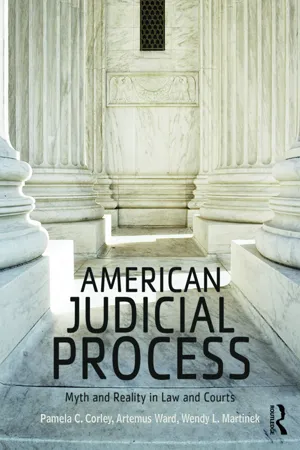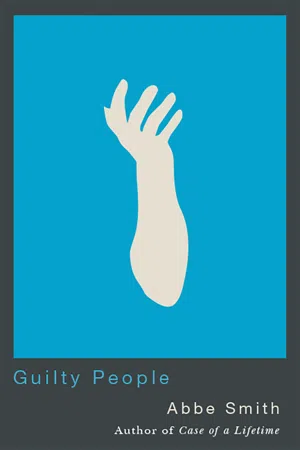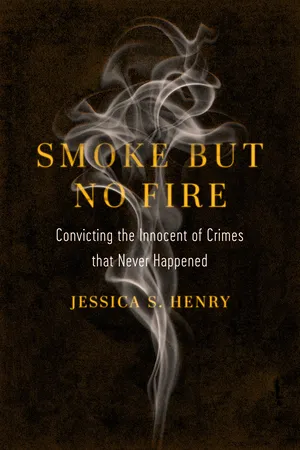Law
Misdemeanors
Misdemeanors are minor criminal offenses that are less serious than felonies. They are punishable by fines, community service, probation, or a short jail sentence. Examples of misdemeanors include traffic violations, disorderly conduct, and petty theft.
Written by Perlego with AI-assistance
Related key terms
6 Key excerpts on "Misdemeanors"
- eBook - ePub
American Judicial Process
Myth and Reality in Law and Courts
- Pamela C. Corley, Artemus Ward, Wendy L. Martinek(Authors)
- 2015(Publication Date)
- Routledge(Publisher)
84 Because they do not result in jail sentences, defendants charged with an infraction do not have a right to jury trial. Defendants may hire attorneys but the state is not required to provide them for defendants who cannot afford them. Minor traffic violations are the most common type of infraction. Other common examples, depending upon the jurisdiction, include jaywalking, littering, building code violations, fishing without a license, drinking alcohol in public spaces, walking a dog off a leash, and possession of less than one ounce of marijuana.Misdemeanors are typically defined as “an offense for which statutorily authorized punishment does not exceed one year in jail.” 85 Punishment for Misdemeanors is not, however, limited to jail but, rather, can also include fines, probation, community service, and restitution for victims. Misdemeanor defendants are entitled to a jury trial and, if the offense is one that results in the possibility of jail time, they are also entitled to a state-appointed attorney if they cannot afford to pay for their own. 86 In theory, this right to counsel supports the notion (read: the myth) that all defendants are equal before the law. The reality of the situation is quite different, however, because “[e]ven the best-run state [public defender] programs lack enough money to provide competent lawyers for all indigent defendants who need them.” 87 Examples of Misdemeanors, which vary from jurisdiction to jurisdiction, include petty theft, trespassing, vandalism, disorderly conduct, public intoxication, and prostitution.Felonies are the most serious crimes and typically involve physical harm (or the threat thereof) to victims. They can also include white-collar crimes 88 (such as embezzlement and insider trading) and fraud schemes (such as bank fraud and credit card fraud). Second or third offenses that would otherwise be Misdemeanors can be elevated to felonies. So, for example, in the state of Texas a first or second DWI offense is considered a misdemeanor while a third such offense is considered a felony. Punishments for felonies include prison sentences from 1 year to life without parole and, for the most serious felonies such as murder, even the death penalty. 89 Defendants are entitled to a jury trial and a court-appointed attorney, though this was not always the case for state crimes. The U.S. Supreme Court had previously held that the right to counsel was crucial when a defendant was charged with a capital crime (that is, a crime for which the death penalty could be imposed), 90 however, it did not extend the right to counsel for state felonies until the well-known case of Gideon v. Wainwright. 91 The story behind Gideon was recounted in the best-selling book Gideon’s Trumpet 92 and subsequently adapted for a made-for-television movie of the same name starring acclaimed actor Henry Fonda (father of Jane and Peter Fonda and grandfather of Bridget Fonda). Examples of felonies include murder, rape, assault, battery, and arson. As these distinctions among infractions, Misdemeanors, and felonies demonstrate, contemporary society categorizes crime seriousness based on violence rather than other factors (such as betrayal of trust), even though some have argued that the latter do the most damage to society. 93 - eBook - ePub
Books, Crooks, and Counselors
How to Write Accurately About Criminal Law and Courtroom Procedure
- Leslie Budewitz(Author)
- 2011(Publication Date)
- Quill Driver Books(Publisher)
3
Crime …IN THE LAST CHAPTER, WE TALKED ABOUT CRIMINAL procedure. Now it’s on to substantive criminal law. You’ll learn the concept of the elements of a crime, how they vary, and how they’re proven—and we’ll see more of those all-important differences in terminology. Then it’s on to a few recurring topics in fact and fiction: gun laws, hacking, juvenile justice, false allegations of abuse, mental competence, and the insanity defense.What’s the difference between a felony and a misdemeanor?The difference is largely one of degree, a reflection of the legislature’s judgment—on behalf of the people—of the seriousness of a crime. Felonies include intentional killings and certain unintentional killings (like vehicular homicide and manslaughter), sexual intercourse without consent, kidnaping, arson, robbery, burglary, escape, and distribution of dangerous drugs. Misdemeanors include possession of small amounts of drugs or drug paraphernalia, disorderly conduct, trespass, indecent exposure, solicitation (aka prostitution), and some traffic offenses.B lack’s Law Dictionary says the root of felony is felonia, “the act or offense by which a vassal forfeited his fee.” Who knew? Misdemeanor, meaning “misdeed,” dates back to fifteenth-century England; it initially meant crimes not subject to forfeiture, but evolved to refer generally to less serious crimes. Merriam-Webster traces hoosegow to the Spanish juzcado, or courtroom; how it came to mean jail is a mystery.Some crimes—notably assault—may be either felonies or Misdemeanors. Some states classify assaults into aggravated or simple, while others define them separately, e.g., partner assault, assault with a deadly weapon, assault on a sports official, with each classified as a felony or misdemeanor. The degree of intent and possible harm makes the difference.Some states establish classes of felonies and Misdemeanors, e.g., A, B, C, with punishment differing for each class. Felonies typically carry prison terms, while Misdemeanors are punished by fines and up to a year in the local hoosegow. - eBook - ePub
- David H. McElreath, Daniel Adrian Doss, Carl J. Jensen III, Michael Wigginton Jr., Ralph Kennedy, Kenneth R. Winter, Robert E. Mongue, Janice Bounds, J. Michelle Estis-Sumerel(Authors)
- 2013(Publication Date)
- Routledge(Publisher)
Deviant behavior also comes to the attention of the police but is different from criminal behavior in that it is not against the law. Behavior that our society labels as deviant includes any behavior that does not conform to the expectations of society. This could be as simple as deviant forms of dress to a group becoming too loud in a public place. Depending on the situation and how disruptive the group becomes, this deviant behavior can quickly turn into criminal behavior such as disorderly conduct. Although deviant behavior can be troublesome to a community, as it applies to law enforcement, it is not the primary focus of resources. It is behavior that has been defined as violating a law or ordnance that will be the focus for police and law enforcement professionals.Crimes can be divided into categories based on their seriousness. The first two categories are Misdemeanors and felonies. Misdemeanors are crimes that are less serious and punishable with a range of sentences from fines to incarceration in a jail for up to a year. Examples of Misdemeanors include disorderly conduct, vandalism, and trespassing. Felonies are more serious crimes that carry a penalty ranging from a year or more in prison to the most extreme sentence of death. Examples of felonies include aggravated assault, rape, and murder.Status offenses are a third category of crime that applies only to individuals who are under a certain age. These behaviors are typically not against the law for an adult but hold a special status for juveniles. Examples of these offenses include truancy, drinking alcohol, curfew violations, and smoking. Most states have specific age limits set for each offense.Criminal Law and Civil Law
Law in the United States can be classified either as criminal law or civil law. Criminal law is concerned with behaviors that are considered to be harmful to society as well as the victim. These laws have been codified at the local, state, and federal level. Criminal law identifies the behavior and the associated punishment with that crime. Because criminal law is considered to include behavior that is harmful to society, the state prosecutes an individual who has violated a criminal law. - eBook - ePub
- Abbe Smith(Author)
- 2020(Publication Date)
- Rutgers University Press(Publisher)
In federal court and most state courts in the United States, a misdemeanor is punishable by one year of incarceration or less; a felony is punishable by more. Although Misdemeanors are considered less serious than felonies, multiple misdemeanor charges can lead to a substantial sentence, and even a single misdemeanor conviction can carry significant collateral consequences—such as loss of housing and educational opportunities—in addition to jail and heavy fines. Moreover, some serious felonies—such as sexual or physical assaults—can be charged as Misdemeanors when there are problems of proof.Still, because they are considered low-level offenses, Misdemeanors do not get the attention—or due process—afforded to felonies. This is so even though the vast majority of criminal cases are Misdemeanors; more than thirteen million are filed every year in the United States.8 As legal scholar Alexandra Natapoff points out, misdemeanor processing is characterized by high-volume arrests, limited screening by police and prosecutors, an overwhelmed defense bar, and high plea rates.9 Together, these engines generate criminal convictions “in bulk,” often without meaningful scrutiny of whether those convictions are supported by evidence or are the product of a lawful arrest.10 Moreover, many misdemeanor defendants are convicted without counsel.11Guilty pleas are prevalent in misdemeanor court because, contrary to conventional wisdom, the accused do not always claim to be innocent. Instead, they often want to plead guilty to “get it over with” or because they did it. Neither of these is a good reason to plead guilty. Good defense lawyers urge clients to allow them to investigate, negotiate, file motions, and make a considered decision about trial versus plea instead of rushing to take a plea.It is especially foolish for a defendant who is out on bail to plead guilty at the first opportunity, because Misdemeanors often fall apart. Time passes, rifts heal, damaged or lost property is replaced, and witnesses fail to appear. Even initially angry crime victims think twice about spending the day in criminal court for a misdemeanor. But clients do not always heed this advice. - eBook - ePub
Smoke but No Fire
Convicting the Innocent of Crimes that Never Happened
- Jessica S. Henry(Author)
- 2020(Publication Date)
- University of California Press(Publisher)
My innocent clients, who were poor and almost always black or brown, invariably took the arraignment plea offer. They didn’t want the very real hassle and inconvenience of having to deal with the criminal court logistics—endless security lines, bag searches, and courtroom delays—even to fight a case that should never have been brought. They could not afford to miss more work. They had no one to watch their children or help their elderly relatives. It was a rare case when my client was willing to litigate a trespass charge to the bitter end. For the few who agreed to return, I filed motions to dismiss their cases. We often, though not always, prevailed. In other cases, my clients started out willing to challenge the charges but eventually decided to plead because the fight was too burdensome.I left the Bronx public defender’s office well before a series of lawsuits were filed, discussed later in this chapter, that challenged the NYPD’s aggressive pursuit of trespass cases and the NYPD’s stop-and-frisk practices in general. But they highlight a much larger problem that exists in urban policing today: the routine and indifferent arrest and processing of massive numbers of poor people of color into and out of our criminal justice system for low-level misdemeanor offenses, many of which never happened in the first place, under the guise of fighting crime.MISDEMEANOR PROCESSING IN THE CRIMINAL JUSTICE SYSTEM (THE BIG PICTURE)
Misdemeanor crimes are crimes that can be punished by up to one year in jail. Minor drug possession, driving while intoxicated, petty theft, prostitution, fare jumping, graffiti, trespassing, loitering, certain assaults, and disorderly conduct are all examples of misdemeanor crimes. By one estimate, 13.2 million misdemeanor cases are filed every year, yielding millions and millions of misdemeanor convictions annually.3How many of these cases involve innocent people who were charged with crimes that did not happen? No one knows the answer to that question. In truth, data about misdemeanor wrongful convictions are scarce. Innocent people who plead guilty in misdemeanor cases are rarely later identified and almost never exonerated for their crimes. In fact, even though misdemeanor cases make up the bulk of crimes in the criminal justice system, they represent less than 4 percent of all known exonerations in the NRE database.4 - eBook - ePub
Misdemeanorland
Criminal Courts and Social Control in an Age of Broken Windows Policing
- Issa Kohler-Hausmann(Author)
- 2018(Publication Date)
- Princeton University Press(Publisher)
how these various forms of dismissal work are essential for understanding how nonconviction, noncustodial dispositions to misdemeanor cases operate in the managerial model. Defendants are marked—sometimes for a very short time and sometimes for a very long time—even if the eventual outcome of the case is a dismissal. This marking serves an important function, even if it is not to trigger the capacity of the state to impose a formal sanction. It allows the state to record the fact of an encounter and to use it as a data point in later encounters. The next prosecutor and judge who encounter a defendant can know whether there was a prior allegation of criminal conduct, and this marking is accomplished without demanding all the time and resources necessary to secure a conviction.Conviction
Between 2010 and 2015, somewhere between 46 and 51 percent of misdemeanor case dispositions have resulted in a conviction.18 Here again, the disposition category of conviction masks variation in the type of conviction, the types of records generated, who may access those records, and by what means. Conviction can occur at any point in a case’s life course: defendants can plead guilty to a misdemeanor crime at arraignment or after years of court appearances.The major fault line lies between a criminal and a noncriminal conviction. In criminal court vernacular, that distinction is described as the difference between taking “a letter” criminal conviction—meaning a Class A or Class B misdemeanor—or a noncriminal violation or infraction conviction—usually a “dis con.” In recent years, approximately 30 percent of all dispositions in which the top arrest charge was a misdemeanor crime resulted in a conviction for a violation or infraction (that is, approximately 58 to 60 percent of all cases terminating in a conviction).19Table 4.1 displays the top conviction charges resulting from a misdemeanor arrest in five-year intervals from 1985 to 2015.20 Comparing these conviction charge counts to the arrest charge data presented in chapter 1 (see fig. 1.5
Learn about this page
Index pages curate the most relevant extracts from our library of academic textbooks. They’ve been created using an in-house natural language model (NLM), each adding context and meaning to key research topics.





